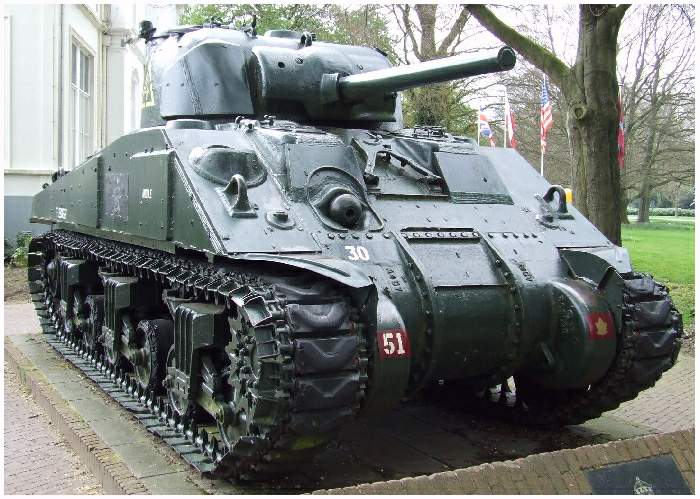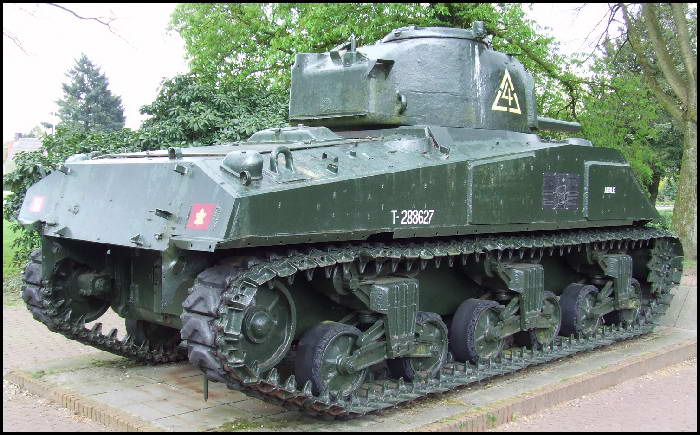|
M4A3 In January 1942 the Ordnance Committee gave permission to use the 500 hp. 8 cylinder V-Ford GAA engine to be used in the M4. The first M4A3 was born. The first prototypes were built at the Ford Motor Company in May 1942. Tested at the General Motors Proving Grounds some adjustments were made and the M4A3 was recommended for production.

The first production M4A3’s, built by Ford, looked identical to the M4 and the M4A2 with the welded hull. For the big difference look at the engine cover on the reardeck. The one on the M4A3 is much larger. Fort seized production of the M4A3 in September 1943 after 1690 were built. Other manufactures took the production over.
when you look at the enginecover


Early 1943 there were such many changes made to the M4A3 that almost a complete new tank was produced. Especially the 47 degrees front plate and ‘Wet Stowage’ for the ammo saw the birth of the ultimate M4A3.

The M4A3 was much used version for the 76mm gun. A total 4542 of M4A3(76) were produced. A new feature was the introduction of the 'Wet Stowage' for the shells. Until then, the shells were placed dry stored in the turret and the hull. The shells from the turret of the M4A3(76)W disappeared under the turret. To prevend explosions when the tank was hit, the shells were placed in tubes filled with water and glycerin.

With the production of the new turret and hull with the 'Wet Stowage' system for the 76mm gun, the M4A3 with the 75mm cannon was also adapted. After the production for the M4A3's, the new turret stayed in production for the previous production M4's. Because of the 'Wet Stowage' the extra armour protection on the side of the Sherman was deleted.

The frontplate of the welled hull was placed steeper, 47 degrees. The production was a lot simpler and the driver and co-driver their hatch became larger. At the front of the hull a gun lock was placed to support the cannon when the tank was transported. Together with the M4 and the M4A1, the M4A3 became the most widely used tank in the American arsenal.

The M4A3 was not delivered in great numbers to other countries. The British army gave the M4A3 the name Sherman IV. With the 76mm cannon there was an extra ‘A’ added (Sherman IVA). Some M4A3's with the 105mm howitzer were delivered to the British, these became known as the Sherman IVB. The total production of the M4A3 was 13.274. Of these, 4542 were delivered with the 76mm cannon and 3039 with 105mm howitzer. The other 5093 were equipped with the standard 75mm cannon.

Total built M4A3 medium tanks: 12.596

M4A3E2
'JUMBO' Of the 5015 M4A3's (with the 75mm cannon) that were built, 254 of these tanks were known as the M4A3E2. These tanks were especially developed to give support to the infantry in Normandy. They had extra armor at the front what brought the thickness to 4 inches (10 cm).

It also had a new turret with a thickness at the front of 6 inches (15 cm). With the extra armor plating the weight got from 33 tons to 42 tons. Some of these M4A3E2's were in the field refitted with the 76mm cannon.

Now a preserved one at the Tank museum in Brussel (below) (notice the extra armour)

M4A4

This M4 had a Chrysler A57 multibank 30-cylinder gasoline engine. It consisted of five ´flathead‘ blocks with 6 cylinders in each one. The five engins were connected in a sort of pentagram configuration. These engines made 2850 r/pm and produced around 425hp.

Because of the size of the engine the rear of the M4A4 was streched. At first sight, the M4A4 looks identical to the M4, but the streched lenght and the engine cover of the M4A4 gives it away.


(with a protective armoured plate atop the engine cover) The maintenance was complicated on these engines and this version was the first who was faced-out of production in September 1943. A total of 7499 were built, all with the 75mm cannon. A great portion, 7167, found it's way to the British army were it was known as the Sherman V. Two were sent to the Soviet Union and 274 to other users.
Total built M4A4 medium tanks:

(notice the bigger distance between the wheels of the bogies with other M4 models) Below is a fascinating picture of an M4A4 which was put out of action in Villers-Bocage, Normandy. The tank belongs to the 5th Royal Horse Artillery, 7th Armoured Division and was brought ashore on LCT 3517. Another feature is the number '33'. This was the weight of the tank which was important for crossing bridges (would it hold or not?). Painted by hand in white was the number '16030', which was the mobilization number.
 These are the first things you may notice. But when you look closer, you notice the barrel of the gun is blown out of the turret. The barrel, together with the mask, is in front of the tank,… When you look closer, you see that the barrel is made out of wood. This is a Observation Post (OP) from K Battery under command by Major Dennis Wells. The real gun was removed to create more space in the turret. The tank was put out of action on June 13, 1944 by a shot from the Tiger of the famous German ace SS-Obersturmbahnführer Michael Wittmann. A first shot landed just in front of the Sherman, but the second was a hit. The entry hole of the armoured piercing shell can be seen on the left side of the turret. The only man on board at the moment was the driver Charles 'Jock' Rae. He managed to escape through the hatch in the floor of the Sherman, but was then hit by shrapnel just below the knee. But Rae managed to return to his own troops, where he was treated for his wounds.
CLICK HERE

A good preserved example of an M4A4 can be found at the former Hartenstein Hotel in Oosterbeek (near Arnhem) in Holland. This is now the great Airborne Museum that has on show some great artefacts from Operation Market-Garden. The tank was placed te commemorate the struggle of the 1st British Airborne who fought here a desperate fight for survival. They were waiting for the tanks of the XXX Corps, but they never came.

|
